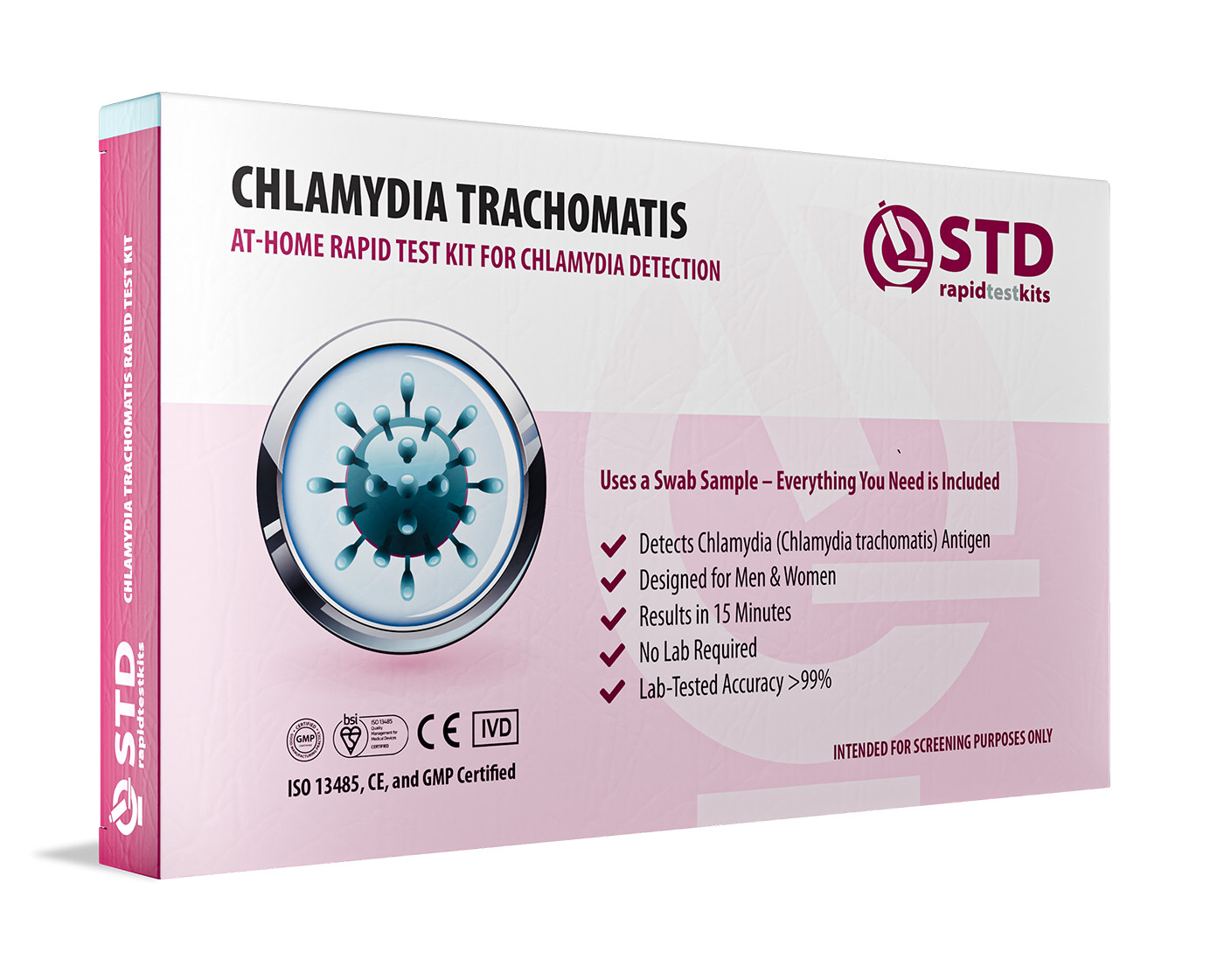Quick Answer: Chlamydia can cause infertility in both women and men, even without symptoms. Testing early is the only way to stop damage before it happens.
When There Are No Red Flags, Only Consequences
The first betrayal of chlamydia is that it rarely makes itself known. For many people, the infection slips in unnoticed, spreading silently. You go about your life, working, dating, maybe trying for a baby, while an invisible bacteria moves through your system, creating inflammation in places that should remain untouched. This is especially true for people with uteruses, where chlamydia often travels from the cervix into the uterus, fallopian tubes, and ovaries.
That inflammation doesn’t just go away. It causes scarring, blocks passageways, and eventually makes it impossible for sperm to reach an egg, or for a fertilized egg to implant properly. Sometimes it causes pelvic inflammatory disease (PID), sometimes it causes tubal factor infertility, and sometimes it simply makes conception harder for reasons even doctors struggle to explain. All from an STD that often leaves behind no clue at all.
“I Thought I’d Know If I Had Something” , Why So Many Miss It
Javon, 29, didn’t think chlamydia was something guys really had to worry about. “I never had pain, no discharge. Nothing weird.” But his girlfriend tested positive during a routine checkup and asked him to get tested too. Turns out, he’d had it for months. He just didn’t know. He had no idea that men can also experience fertility complications from untreated chlamydia, including epididymitis, a painful swelling in the tubes that carry sperm, which can reduce sperm quality and mobility over time.
For both men and women, the silence of chlamydia is where the danger lies. It's not that it’s the most aggressive infection, it’s that it’s so often ignored. And once damage is done, it’s not always reversible. That’s why catching it early, even in the absence of symptoms, is key to protecting long-term health.
Timeline of Trouble: How Fast Can Chlamydia Affect Fertility?
This is the part no one tells you: chlamydia doesn’t need years to do harm. In some people, damage can begin in a matter of weeks, especially if the infection isn’t cleared or continues to spread to sensitive reproductive structures. For others, it might take longer, especially if their immune system manages to contain the infection or if they’re unknowingly reinfected through a partner.
Based on observational studies and clinical data, let's divide it into some approximate time periods:
| Stage | Timeframe | What May Be Happening |
|---|---|---|
| Initial Infection | 0–14 days | Often asymptomatic; bacteria establish in genital tract |
| Silent Spread | 2–6 weeks | Bacteria ascend; potential inflammation in cervix, urethra, or fallopian tubes |
| Complication Window | 6 weeks–6 months | Risk of PID, tubal scarring, or epididymitis increases |
| Long-Term Damage | 6 months–1+ year | Possible infertility, ectopic risk, sperm motility issues |
Table 1. Estimated progression timeline of untreated chlamydia. Individual outcomes vary based on immune response, reinfection risk, and anatomy.
What this means: you could have chlamydia today, feel completely fine, and by the time you’re thinking about family planning a year from now, it may already be too late to undo the damage. That’s not fear, it's biology.

People are also reading: You Didn’t Even Have Sex, So Why Do You Have an STD
Why It’s Worse for People with Uteruses, But Men Aren’t Off the Hook
The reproductive system in people assigned female at birth is more vulnerable to long-term chlamydia damage because of its internal complexity. Once the infection passes the cervix, it can reach the fallopian tubes, which are delicate and prone to scarring. These scars can block eggs from traveling, increase the chance of ectopic pregnancy, or cause permanent infertility.
But men aren’t immune. In fact, chlamydia-related infertility in men is an area of increasing concern. Chronic untreated infections can lower sperm count, damage DNA quality in sperm, and contribute to inflammation in the prostate and epididymis. Some men may notice occasional discomfort during urination or ejaculation, but many report nothing at all, until a partner’s fertility struggles prompt investigation.
And here’s the truth: even if chlamydia doesn’t make you infertile directly, it increases the risk of needing expensive fertility treatments, surgical interventions, or months (if not years) of trying before success. That’s the cost of not knowing.
Check Your STD Status in Minutes
Test at Home with RemediumChlamydia Test Kit

 For Men & Women
For Men & Women Results in Minutes
Results in Minutes No Lab Needed
No Lab Needed Private & Discreet
Private & DiscreetOrder Now $33.99 $49.00
“I Got Tested Too Late”: How People Discover the Damage
Nadia had been trying to conceive for over a year. Everything looked “normal” on paper, hormones balanced, ovulation regular, but her HSG scan (a test that checks for blockages in the fallopian tubes) showed one side completely blocked. The doctor asked, “Have you ever had chlamydia?” She hadn’t, or so she thought. But a past partner had cheated, and she never got tested after they split. A blood test revealed prior exposure. The damage was done quietly, years ago.
These are not isolated cases. Studies show that up to 30% of untreated chlamydia infections in women may lead to pelvic inflammatory disease (PID), and about 1 in 5 of those cases result in fertility complications. For men, long-term effects may show up as low sperm count or inflammatory blockages in the vas deferens. The problem is that chlamydia rarely leaves visible scars on the outside, but internally, it can change the trajectory of your life.
And that’s why timing matters. Testing isn’t just about peace of mind, it’s about preventing silent harm from turning permanent.
When to Test, Retest, and Test Again
If you’ve had unprotected sex, even once, with a partner whose status you don’t know, it’s worth testing for chlamydia. The CDC recommends screening for sexually active women under 25, older women with new or multiple partners, and men who have sex with men. But the truth is, anyone sexually active is at risk. It doesn’t matter if you used condoms (they reduce risk but don’t eliminate it), or if it was “just oral.” Chlamydia can still transmit through genital, anal, and oral contact.
Testing is usually done via urine sample or a vaginal/cervical swab. It’s painless, fast, and increasingly available in at-home test formats. But here's where it gets tricky: the timing. You might get a false negative if you test too soon after being exposed, especially if the bacteria haven't grown enough to be found yet.
Here is what testing schedules usually look like:
| Situation | Best Time to Test | Why Timing Matters |
|---|---|---|
| New sexual partner | 14 days post-contact | Allows for full bacterial incubation; reduces false negatives |
| Partner tested positive | Immediate test + retest at 14 days | Early test catches current infection; retest ensures accuracy |
| Recurring urinary or vaginal symptoms | Test ASAP | Even mild symptoms may signal an active infection |
| Trying to conceive | Before conception efforts begin | Ensures no silent infections impacting fertility |
Table 2. Testing timelines for different exposure or risk scenarios. Retesting may be recommended depending on incubation and test type.
And if you test negative but your symptoms persist, or your partner tests positive, you should test again. It’s not paranoia. It’s precaution. Your reproductive future may depend on it.
How to Get Tested Without Judgment (or a Doctor’s Office)
For many people, the fear of judgment keeps them from getting tested. Maybe you live in a small town where everyone knows your business. Maybe you had a one-time hookup and feel embarrassed. Maybe you're queer, nonbinary, or in a situation where disclosing your sexual history doesn’t feel safe. That’s why STD Rapid Test Kits exist, to offer a discreet, private, doctor-trusted way to get answers without the shame spiral.
You can order a chlamydia rapid test online, take it at home, and get results within minutes. No awkward questions. No waiting rooms. Just you, your result, and a next step you can take immediately. For broader coverage, a Combo STD Home Test Kit can screen for multiple infections at once, including gonorrhea, syphilis, and HIV.
Testing at home doesn’t mean testing alone. Many platforms offer guidance, follow-up options, and links to telehealth treatment if you need it. The most important step is just taking it. Because doing nothing lets silence win, and that silence can cost your fertility.
“I Got Treated Just in Time”, When a Test Changed Everything
Malik didn’t think much of the occasional burning he felt after sex. He chalked it up to dehydration or friction. It wasn’t until his partner insisted on both of them getting tested that he agreed. His rapid test came back positive for chlamydia. A quick round of antibiotics later, his symptoms disappeared, and more importantly, the infection was caught before it could do real harm.
“It made me rethink everything,” he said. “I almost ignored it. But that test probably saved my ability to have kids later.”
And that’s the core message here. Testing isn’t about being paranoid, it’s about being proactive. It’s about protecting a part of yourself you might not be thinking about yet, but that future-you will care deeply about. Fertility is often something we don’t worry about until it’s on the line. Chlamydia doesn’t wait for that moment. So don’t wait either.
Myth: You’ll Know If Something’s Wrong
This one causes more damage than most infections: the belief that if something was wrong, you’d feel it. It’s the myth that convinces people they’re fine if there’s no burning, no odor, no visible symptoms. But chlamydia thrives on invisibility. It doesn’t always cause pain. It doesn’t always show up in obvious ways. And by the time it does, it might already have changed the shape of your reproductive future.
Some people get mild signs, spotting between periods, unusual discharge, or pelvic discomfort, but many chalk it up to stress, hormonal shifts, or even a yeast infection. Others notice nothing at all. And if you’re someone with a uterus, this lack of symptoms doesn’t mean lack of risk. Quite the opposite.
Because even without warning signs, chlamydia can still travel up the reproductive tract, triggering inflammation that scars fallopian tubes and creates blockages that sperm can’t pass. The silence isn’t harmless. It’s dangerous.
How Pelvic Inflammatory Disease (PID) Begins, and Why It Matters
When chlamydia is left untreated, especially in women, it can cause PID, a serious infection that affects the uterus, fallopian tubes, and ovaries. This condition is a leading cause of infertility. According to the CDC, about 1 in 8 women with a history of PID will have difficulty getting pregnant. The worst part? Many don’t even know they had PID in the first place. It can begin subtly, with cramping or spotting, or it can explode suddenly with fever, pain, and vomiting.
Let’s break down the ripple effect of untreated chlamydia leading to PID and infertility:
| Progression | Typical Timeline | Potential Outcome |
|---|---|---|
| Asymptomatic chlamydia | 0–4 weeks post-exposure | Unnoticed spread to cervix or urethra |
| Early PID | 4–12 weeks | Mild pelvic pain, fatigue, possible low fever |
| Established PID | 3+ months | Inflammation causes tubal scarring and fertility damage |
| Late-stage consequences | 6 months–1 year+ | Infertility, ectopic pregnancy, chronic pelvic pain |
Table 3. PID development from untreated chlamydia. Outcomes depend on how early the infection is detected and treated.
Prevention doesn’t just mean condoms. It means testing. It means listening to your body, but also not waiting for your body to scream before you act. PID is preventable. But only if the infection causing it is caught in time.

People are also reading: Cold Sores and Kissing: What You Need to Know Before You Hook Up
What About Chlamydia During Pregnancy?
Many people only learn they have chlamydia because they get tested during routine prenatal visits. If you’re pregnant and have chlamydia, it’s not just your fertility at risk, it’s your baby’s health, too. Untreated chlamydia can lead to premature birth, low birth weight, or transmission to the baby during delivery, potentially causing eye infections or pneumonia in newborns.
The good news? Chlamydia is easily treatable during pregnancy with antibiotics that are safe and effective. But again, early detection is everything. Prenatal screenings are a safeguard, but if you’re not pregnant yet, or trying, testing before conception can protect both your ability to get pregnant and your future child’s wellbeing.
Check Your STD Status in Minutes
Test at Home with Remedium6-in-1 STD Rapid Test Kit

 For Men & Women
For Men & Women Results in Minutes
Results in Minutes No Lab Needed
No Lab Needed Private & Discreet
Private & DiscreetOrder Now $119.00 $294.00
For all 6 tests
Queer, Trans, and Nonbinary Readers, This Affects You Too
Chlamydia doesn’t care about your orientation or identity. It spreads through mucous membranes, vaginal, anal, oral, and anyone with those tissues is at risk. That means lesbian, gay, bisexual, trans, and nonbinary individuals are just as vulnerable, often more so due to medical bias, poor screening protocols, or lack of targeted health education.
One study found that transmasculine people were significantly less likely to be offered regular STI screenings, even though many remained sexually active with partners who could transmit infections. Similarly, queer women often report being told they “don’t need testing” if they’re not having penis-in-vagina sex, which is patently false. Chlamydia can spread via shared toys, fingers, and oral sex too.
If you’ve ever been told you’re not “at risk,” this is your sign to ignore that gatekeeping. You deserve care. You deserve to know. You deserve to be tested on your terms. STD Rapid Test Kits are discreet, private, and can be done without judgment, whether you're queer, cis, nonbinary, or figuring things out as you go.
Stigma Isn’t a Symptom, But It Still Spreads
Shame is the second infection. It stops people from asking questions, from getting tested, from being honest with themselves or their partners. It makes silence feel safer than truth. But when it comes to chlamydia, that silence does damage. It delays treatment. It increases risk. And it can steal the chance at a biological child, not because you did something wrong, but because you weren’t allowed to talk about it freely.
Here’s the real talk: STDs happen. To people who are careful. To people who use protection. To people in monogamous relationships. To people who were just experimenting. You don’t need to apologize for being human. But you do need to protect yourself. Testing isn’t a confession. It’s care. It’s control. It’s how you protect the version of yourself you’re still becoming.
If it’s been a while since you were tested, or if you never have, there’s no better time. Your body isn’t waiting. Neither should you.
FAQs
1. Can I really have chlamydia and not know it?
Yes. And that’s exactly how it keeps spreading, and stealing fertility. Most people with chlamydia feel totally fine. No burning, no discharge, no pain. It can sit quietly for weeks or even months. By the time symptoms show up, if they ever do, it might’ve already reached your reproductive organs. That’s why regular testing matters even if you “feel healthy.”
2. How fast can chlamydia mess with your fertility?
Faster than you'd expect. For some, inflammation can start damaging fallopian tubes within a few weeks. For others, it builds silently over months. There’s no magic number, but every day untreated is a roll of the dice. If you’re trying to conceive, or think you might want to someday, don’t wait for symptoms to tap you on the shoulder. They might never come.
3. What about men? Can chlamydia mess with their fertility too?
Yep. It’s not just a “women’s issue.” In men, chlamydia can lead to swollen tubes (epididymitis), painful ejaculation, or even reduced sperm quality. We’ve seen guys with no symptoms test positive, and later find out it was hurting their fertility the whole time. So yes, guys, get tested. Silence isn’t protection.
4. I already had chlamydia and got treated, am I in the clear?
Maybe, maybe not. If you caught it early and treated it fast, you're likely okay. But if it went untreated for a while, especially if you had symptoms like pelvic pain or irregular periods, there could be some lingering effects. You might never know unless you start trying for kids and things don’t go as planned. A fertility check-up isn’t a bad idea if you're concerned.
5. Do I have to tell my current partner I had chlamydia in the past?
Only if you want to. You’re not legally required unless they’re at risk. But many people appreciate the honesty, especially if you’re about to stop using protection or try for a baby. You can say something as simple as, “Hey, I got treated a while ago, just wanted to share.” That’s not weakness, it’s care.
6. Does chlamydia always turn into PID?
Nope, but it can. Not everyone with chlamydia develops PID (pelvic inflammatory disease), but when it does happen, it’s usually because the infection went untreated and traveled upward. PID is one of the top causes of infertility in women. So it’s not guaranteed, but it’s a risk you don’t want to gamble with.
7. Can condoms fully prevent chlamydia?
They help. A lot. But they’re not a guarantee. Chlamydia can still be transmitted through areas not covered by a condom (think oral sex or skin-to-skin around the genitals). So use protection, yes, but also test regularly if you're sexually active. It’s not about paranoia. It’s about knowing what’s up.
8. Is there any way to know if I’m already infertile from chlamydia?
Not without testing, and not just STD testing. You’d need fertility-specific tests: a sperm analysis, or a hysterosalpingogram (that tube-flushing scan you may have heard of). If you’ve had chlamydia in the past and are trying to conceive, those tools can offer real answers, not just guessing games.
9. Can chlamydia go away on its own?
Technically possible, but not worth counting on. Some people's immune systems may suppress it temporarily, but that doesn’t mean it's gone, or that damage isn’t happening behind the scenes. One round of antibiotics is way safer than months of hoping it “clears on its own.”
10. Why does no one talk about this?
Because STD stigma is still real, and most people don’t want to admit they’ve had one, especially one that might affect fertility. But the more we talk, the more we catch infections early. The more we test, the less harm they cause. So talk. Ask. Share this post. You could literally be saving someone’s chance at a future family.
Before You Panic, Here’s What to Do Next
This isn’t about fear, it’s about facts. Chlamydia is treatable. Damage isn’t inevitable. But knowledge is power, and silence is what makes this infection so dangerous. You don’t have to wonder. You don’t have to wait.
Don’t leave your future to guesswork, get tested. Order a discreet chlamydia test or get the full Combo STD Home Test Kit today. It’s fast, private, and one of the most empowering things you can do for yourself.
How We Sourced This Article: We combined current guidance from leading medical organizations with peer-reviewed research and lived-experience reporting to make this guide practical, compassionate, and accurate.
Sources
1. Mayo Clinic – Pelvic Inflammatory Disease Overview
2. Planned Parenthood – Chlamydia
3. American Sexual Health Association – Chlamydia
4. World Health Organization – Sexually Transmitted Infections (STIs) Fact Sheet
5. Planned Parenthood – Chlamydia
About the Author
Dr. F. David, MD is a board-certified infectious disease specialist focused on STI prevention, diagnosis, and treatment. He blends clinical precision with a no-nonsense, sex-positive approach and is committed to expanding access for readers in both urban and off-grid settings.
Reviewed by: Alyssa Tran, MPH | Last medically reviewed: November 2025
This article is only for information and should not be used as medical advice.










